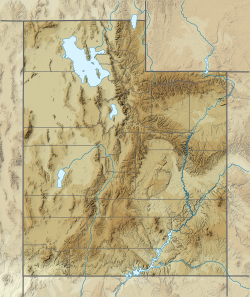| Wingate Sandstone | |
|---|---|
| Stratigraphic range: Rhaetian-Hettangian ~ | |
 Wingate Sandstone cliffs in the San Rafael Swell, Utah | |
| Type | Geological formation |
| Unit of | Glen Canyon Group |
| Underlies | Kayenta Formation |
| Overlies | Chinle Formation |
| Lithology | |
| Primary | Eolian sandstone |
| Location | |
| Coordinates | 39°06′N109°06′W / 39.1°N 109.1°W |
| Approximate paleocoordinates | 17°42′N48°18′W / 17.7°N 48.3°W |
| Region | northern Arizona, northwest Colorado, Nevada, Utah |
| Country | United States |
| Extent | Colorado Plateau |
| Type section | |
| Named for | Fort Wingate |
| Named by | C.E. Dutton |
The Wingate Sandstone is a geologic formation in the Glen Canyon Group of the Colorado Plateau province of the United States which crops out in northern Arizona, northwest Colorado, Nevada, and Utah.



